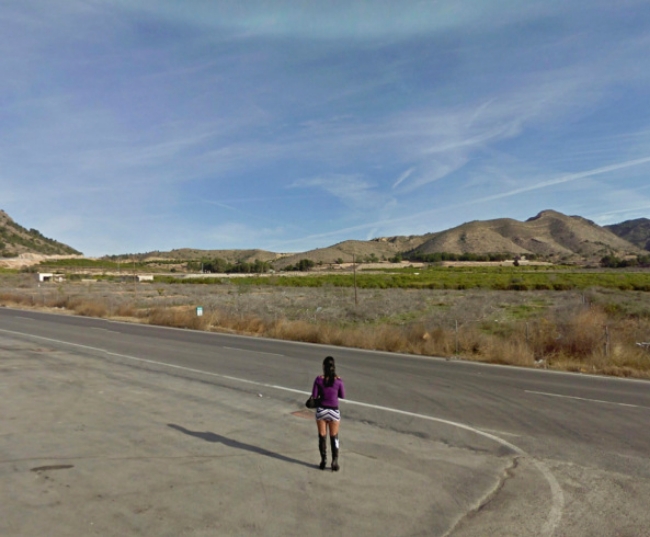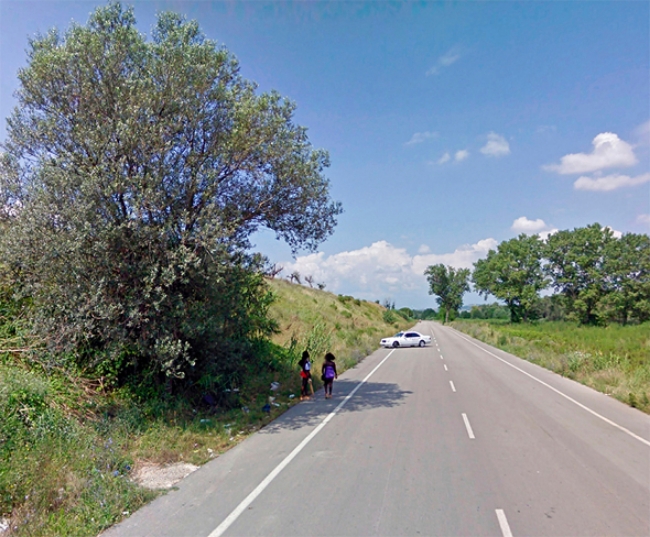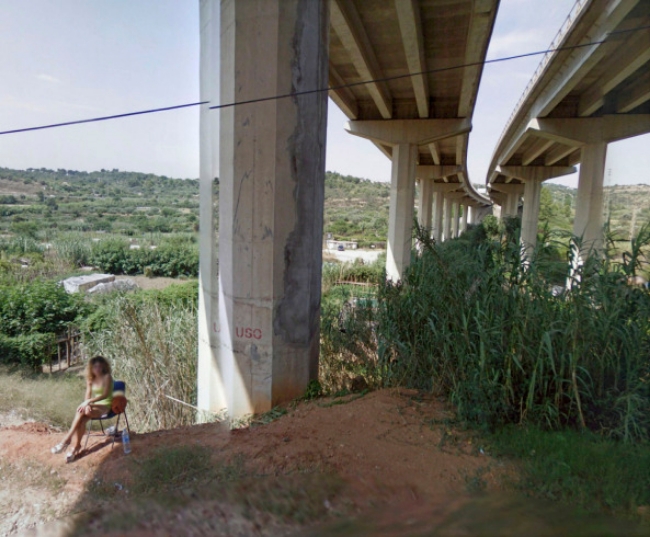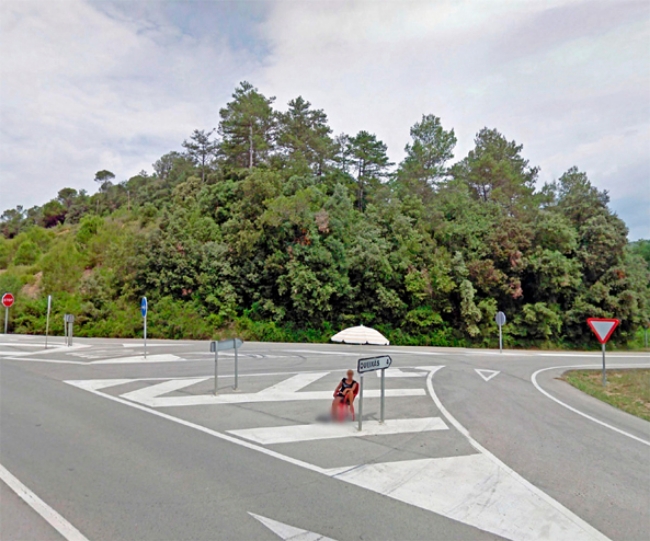We all know how to do photography. You take a camera in hand, you find a thing you want to photograph, you point the camera at that thing, you release the shutter. The photographer has a reason for taking that photograph; the photographer decides what is photographed and how it’s photographed. The resulting image is an expression of the photographer’s interaction with the world.
What could be simpler?
That’s exactly how Mishka Henner used to do photography. It’s not necessarily how he does photography now.

Although he was born in Brussels, Belgium in 1976, Henner obtained his higher education in England. Did he study art? Did he study painting or photography? No, he did not. He studied sociology. He attended Loughborough University from 1994 to 1997, and Goldsmiths College from 1997 to 1998. He knocked around London for a few years (which is what one so often does with a degree in sociology). He tried his hand at a number of creative outlets – painting, writing, the theater.
Then in 2003 he attended the Cruel and Tender exhibit at the Tate Modern. The photography exhibit was devoted to “the quiet documentation of overlooked aspects of our world, whether architecture, objects, places or people.” It was the sort of exhibit that would appeal to a sociologist’s eye.
Henner described the exhibit as “life-changing.” He decided to become a documentary photographer. He spent the next six years working with Toronto-born photographer Liz Lock on a variety of documentary projects. They shot portraits, they accepted commissions from the Financial Times and The Independent, they engaged in a wide variety of long-term documentary projects. Henner, in the course of those six years, had become a successful documentarian.
“I found that I could discover something new by pointing a camera,” Henner said, “but the more proficient I became with the language of photography, the more frustrated I was with it. I wanted to find new ways of communicating.” That led him to do something dangerous. He began to think about the nature of photography.

As he began to consider the essential qualities of the documentary process Henner became increasingly disillusioned with it. He stated the act of making documentary images was:
“…wrapped up in all sorts of relationships between yourself, your subjects, and your backers. It has little to do with truth. Positions are constantly negotiated and shifting, it’s something you carve out as you go along, employing all sorts of tricks and devices to search for convey authenticity.”
That’s as much a sociological observation as it is an artistic one. Documentary photography requires the photographer to take a politico-social position in relation to the subject matter, just as the photographer must take a physical position in relation to the subject of the photograph. As Wim Wenders once put it, “The most political decision you make is where you direct people’s eyes.”
One of the last projects Henner worked on with Ms. Lock was about street prostitution in Manchester, England. While doing his research, he discovered an online community of men who used the ‘Street View’ feature of Google Maps to share the locations of prostitutes.
Google Street View (GSV) was a revelation to Henner. He became aware of the existence of a truly massive collection of images — images that were truly documentary — that were widely available and easily accessible, but that remained largely unseen. “We don’t need to carry a camera around with us all the time anymore,” Henner says, “because everything is being photographed in any case.” Henner realized he didn’t have to do photography the way it has always been done. Why shoot a new photograph when he could simply access and appropriate unseen photographs that already exist?

Henner found similar online communities of men who used GSV in Italy and Spain to locate roadside sex workers. He used that information to compile a series of images which he called No Man’s Land.
There is, of course, a long historical tradition of imagery of prostitutes – not just in photography, but in painting. That tradition is grounded in the notion that art should evoke a specific emotion in the viewer – lust, guilt, pity, embarrassment, empathy, sympathy. In contrast, Henner says his motivation isn’t to evoke any particular emotion at all; it’s just to make people think. He says,
“I now consider the burden of sympathy expected from a narrow language of documentary to be a distracting filter in the expression of much more complex realities. Pity has a long and well-established aesthetic and I just don’t buy it anymore. In themselves the facts are terrible and I don’t need a sublime image to be convinced of that. In the context of representing street prostitution, striving for the sublime seems a far more perverse goal to me.”
Unlike most documentary photography dealing with sex workers, Henner’s No Man’s Land doesn’t take a moral, ethical, or political position. It’s simply an acknowledgment of existing conditions. That absence of position is made possible by the simple fact that no human agency was involved in shooting the photographs.

William Eggleston coined the term ‘democratic camera’ to describe the notion that anything is worth photographing. But even with the most democratic camera there is an aesthetic determination made by the photographer before the camera is aimed and the shutter is released. The camera must be pointed at something by somebody. Google Street View removes the photographer from the documentary process. It removes aesthetics. It removes more than a century of tradition about what constitutes the act of photography.
There is no camera in a hand. There is nobody looking for something to photograph, nobody to decide what is worth photographing and what isn’t. There is nobody to point the camera, nobody to release the shutter. There is no human motivation for taking the photo, no human to decide what is photographed or how it’s photographed. The photograph is NOT an expression of the photographer’s interaction with the world because there is no photographer. There is a machine.
Because there is no photographer, there’s no photographer’s discretion and there’s no artistic influence. Because there’s no photographer, there are no standards of skill or craft to be met. GSV could be said to be the purest form of documentary photography.

There are, of course, other photographers who have used GSV as a tool. What makes Henner’s No Man’s Land different isn’t just that it subverts the traditional practice of photography. It’s different because it was just the opening salvo in what has become a barrage of non-traditional conceptual works of documentary photography.
Henner doesn’t call himself a conceptual artist, but he says the conceptual art movement…
“…smashed through so many pretensions and facades that it appealed to me in a big way, especially in the work of appropriation artists. It was still documentary to me, but not as we knew it…. Now, I’m happiest when I’m making something that doesn’t look or feel like documentary photography but still manages to address a social context.”
Next week the Sunday Salon will examine some of Henner’s newer work to see ‘something that doesn’t look or feel like documentary photography but still manages to address a social context.’ We’ll look at how he’s expanded the notion of the robotic democratic camera to address an ever-widening range of issues and topics. We’ll see how Mishka Henner has found a way to infuse art and passion into neutral observation.
We’re not done with Mishka Henner.
